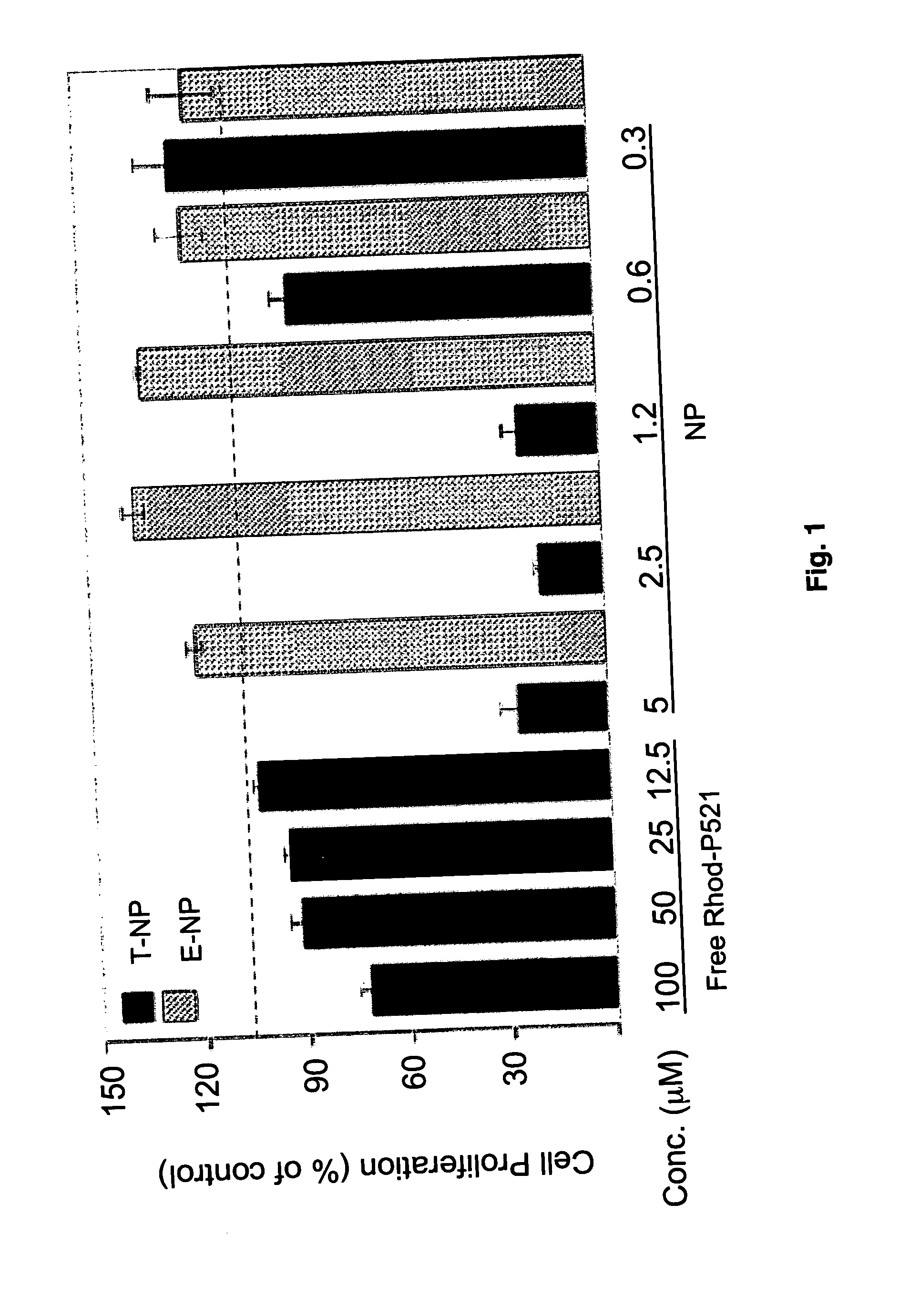Nanoparticular targeting and therapy
a technology of nanoparticles and targeted therapy, which is applied in the direction of nanocapsules, pharmaceutical delivery mechanisms, capsule delivery, etc., can solve the problems of limited doses that a patient can tolerate, high toxicity of chemotherapeutic drugs, and prior art lack of methods for delivering drugs or other therapeutics, etc., to achieve the effect of enhancing the capacity to inhibit endothelial cell growth
- Summary
- Abstract
- Description
- Claims
- Application Information
AI Technical Summary
Benefits of technology
Problems solved by technology
Method used
Image
Examples
example 1
Anti-Angiogenic Factor-Loaded Nanoparticle
[0066] Particles were generated using a droplet-forming core polyanionic solution of 0.05 wt% LMW sodium alginate (LMW-SA), 0.05 wt% chondroitin sulfate (ChS) and 0.05 wt-% TSP-1 in 0.01 M pH 4.2 acetate buffer, and a corona-forming polycationic solution of 0.05 wt-% spermine hydrochloride (SH) and 0.05 wt-% poly(methylene-co-guanidine) hydrochloride (PMCG). Typical ranges of concentrations for these polymers are 0.03-0.06 wt % for LMW-SA, 0.03-0.06 wt % for ChS, 0.03-0.06 wt % for SH, and 0.035-0.55 wt % for PMCG,.
[0067] The polymers were low viscosity sodium alginate (Protanal© LF 5 / 60) from Drammen, Norway) of average molecular weight 12,000; chondroitin sulfate from Sigma Chemical Co., St. Louis Mo., average molecular weight 20,000; poly(methylene-co-guanidine) hydrochloride (PMCG) from Scientific Polymer Products, Inc. (Ontario, N.Y.), with average molecular weight 5,000; spermine hydrochloride (SH) from Sigma, molecular weight 348.2...
example 2
Anti-Angiogenic Factor-Loaded Crosslinked Nanoparticle
[0069] These particles were generated using the same solutions as in Example 1, except the droplet forming solution contained additional polymer, DPA and 125I-labeled TSP-1 instead of nonlabeled TSP-1. DPA is dextran polyaldehyde (CarboMer, Westborough, Mass.) with an average molecular weight of 40,000. The TSP-1 labeling was done by means of a labeling kit (Pierce).
[0070] The particles were formed instantaneously, allowed to react for 1-hour and their size and charge evaluated in the reaction mixture. The average size was 250 nm and the average charge 25.5 mV. The particles were separated by washing twice with 0.01 M acetate pH 4.2 buffer and centrifugation and were incubated for 30 min in a HEPES buffer at pH 8.0 to perform the crosslinking reaction between the polymer constituents and TSP-1. Finally, nanoparticles were washed and centrifuged with 0.01 M acetate pH 4.2 buffer.
[0071] The DPA / TSP-1 mass ratio was: 0 (no cross...
example 3
Nanoparticles with Covalent Conjugation of Peptide Molecule to the Periphery (Anti-Angiogenic Formulation) and their Targeting In Vivo
[0074] A drug peptide or targeting peptide may be conjugated to a 30 polymer to reduce the rate of release of a peptide. TSP-517 is a peptide of 1642 Da derived from the thrombospondin molecule, and has the amino acid sequence KRAKQAGWSHWAA (SEQ ID NO.1). This peptide has a heparin-binding motif and is capable of binding to sites on the tumor vasculature. TSP-517 peptide was synthesized by solid-state chemistry in-house (14).
[0075] To incorporate TSP-517 into nanoparticles, the peptide was conjugated to the outer shell of the nanoparticles as in Example 1 in a stoichiometric ratio through a covalent attachment of the ligand directly to the outer surface amino groups of polycations residing on the nanoparticle periphery. 1-ethyl-3-(3-dimethylaminopropyl)carbodiimide hydrochloride (EDC) was used to link acid residues of the targeting ligand with amin...
PUM
| Property | Measurement | Unit |
|---|---|---|
| Frequency | aaaaa | aaaaa |
| Frequency | aaaaa | aaaaa |
| Flow rate | aaaaa | aaaaa |
Abstract
Description
Claims
Application Information
 Login to View More
Login to View More - R&D
- Intellectual Property
- Life Sciences
- Materials
- Tech Scout
- Unparalleled Data Quality
- Higher Quality Content
- 60% Fewer Hallucinations
Browse by: Latest US Patents, China's latest patents, Technical Efficacy Thesaurus, Application Domain, Technology Topic, Popular Technical Reports.
© 2025 PatSnap. All rights reserved.Legal|Privacy policy|Modern Slavery Act Transparency Statement|Sitemap|About US| Contact US: help@patsnap.com

